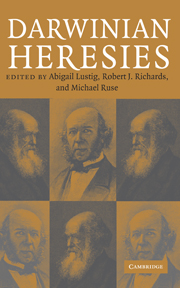Book contents
- Frontmatter
- Contents
- List of Contributors
- 1 Introduction: Biologists on Crusade
- 2 Russian Theoretical Biology between Heresy and Orthodoxy: Georgii Shaposhnikov and His Experiments on Plant Lice
- 3 The Specter of Darwinism: The Popular Image of Darwinism in Early Twentieth-Century Britain
- 4 Natural Atheology
- 5 Ironic Heresy: How Young-Earth Creationists Came to Embrace Rapid Microevolution by Means of Natural Selection
- 6 If This Be Heresy: Haeckel's Conversion to Darwinism
- 7 Adaptive Landscapes and Dynamic Equilibrium: The Spencerian Contribution to Twentieth-Century American Evolutionary Biology
- 8 “The Ninth Mortal Sin”: The Lamarckism of W. M. Wheeler
- 9 Contemporary Darwinism and Religion
- Index
2 - Russian Theoretical Biology between Heresy and Orthodoxy: Georgii Shaposhnikov and His Experiments on Plant Lice
Published online by Cambridge University Press: 11 July 2009
- Frontmatter
- Contents
- List of Contributors
- 1 Introduction: Biologists on Crusade
- 2 Russian Theoretical Biology between Heresy and Orthodoxy: Georgii Shaposhnikov and His Experiments on Plant Lice
- 3 The Specter of Darwinism: The Popular Image of Darwinism in Early Twentieth-Century Britain
- 4 Natural Atheology
- 5 Ironic Heresy: How Young-Earth Creationists Came to Embrace Rapid Microevolution by Means of Natural Selection
- 6 If This Be Heresy: Haeckel's Conversion to Darwinism
- 7 Adaptive Landscapes and Dynamic Equilibrium: The Spencerian Contribution to Twentieth-Century American Evolutionary Biology
- 8 “The Ninth Mortal Sin”: The Lamarckism of W. M. Wheeler
- 9 Contemporary Darwinism and Religion
- Index
Summary
Everyone is heretical, everyone is orthodox.
Umberto Eco, The Name of the RoseSuch expressions as “orthodox Darwinian” and “unorthodox theorist” don't usually require definition. For each scientist in a conversation understands clearly what “orthodox Darwinian” means. At the same time, it is obvious that the understanding of “orthodox Darwinian” changes with time and depends on context. Darwinian evolutionary theory became commonplace among biologists, a part of the basic canon of life sciences. The main disputes were about whether Darwinian biology was the best one, whose position was the most orthodox, and whose positions were heretical. Undoubtedly, at certain periods what would have been considered orthodox among American geneticists would have been perceived as heretical among French experts, and vice versa. This chapter deals with the history of Russian evolutionary biology from 1930s to the 1980s. We will attempt to show how in Russian biology the very idea of what being an orthodox evolutionist meant and what being a heretic meant was modified in different contexts.
In our study, we use the life and work of one entomologist as a case study. Georgii Shaposhnikov (1915–1997) was a taxonomist of plant lice (Aphidoidea), a group of insects with a peculiar life cycle and biology. His experiments producing rapid speciation in aphids were widely discussed by major players in the field of evolutionary biology, as the experiments seemed to fit well into many theoretical frameworks. At various times, these experiments were used as arguments to support quite different evolutionary mechanisms.
- Type
- Chapter
- Information
- Darwinian Heresies , pp. 14 - 47Publisher: Cambridge University PressPrint publication year: 2004
- 2
- Cited by



